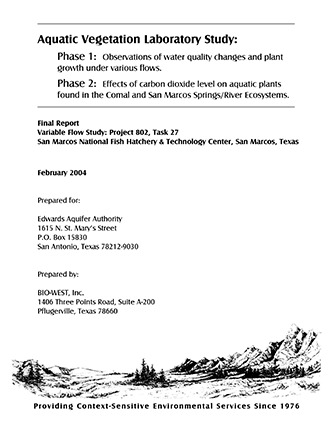Aquatic Vegetation Laboratory Study: Phase 1: Observations of water quality changes and plant growth under various flows. Phase 2: Effects of carbon dioxide level on aquatic plants found in the Comal and San Marcos Springs/River Ecosystems. Final Report Variable Flow Study: Project 802, Task 27 San Marcos National Fish Hatchery & Technology Center, San Marcos, Texas

| Author | BIO-WEST Inc |
| Year | 2004 |
| Description | Study on effects of changing flow rates and CO2 levels on six species of aquatic vegetation found in the Comal and San Marcos River/Springs ecosystems |
| Report Number | San Marcos National Fish Hatchery & Technology Center Variable Flow Study: Project 802, Task 27 |
| Publisher | BIO-WEST Inc |
| Location | Comal River, Comal Springs, San Marcos River, San Marcos Springs |
| Cover | View Download |
| File | View Download |
| Summary |
|
[From the Executive Summary] A two-phase study was conducted during the summer and fall of 2003 to evaluate impacts of different flow levels on individual water quality parameters and the corresponding effects on aquatic vegetation found in the Comal and San Marcos Springs/River ecosystems. …. Abundant plant species and those that harbor high densities of threatened/endangered species were chosen for the study. The study was conducted at the San Marcos National Fish Hatchery and Technology Center (NFHTC) in San Marcos, Texas. … A series of “living streams” in the nursery that receive a continuous flow of Edwards Aquifer groundwater were used in the study. BIO-WEST manipulated conditions in the living streams to allow for different flows (Phase 1) and different water chemistry (Phase 2) among tanks. Phase 1 of the study was observational and designed to evaluate changes in water chemistry that occur under various flow levels and also examine growth and overall health of Vallisneria sp. and Ludwigia repens under the same range of conditions. The experiment was not designed to allow for statistical analysis, but observations of plant response to the range of flow conditions indicate that the quantity of flow affects plant growth and health. The plants exposed to the lowest flow conditions were faded-green in color with leaves that exhibited weak structural support. Although all plants increased in size during the experiment, these plants grew less than those in tanks with greater flow. Among the observed water chemistry changes, variation in carbon dioxide (CO2) was greatest and most likely to have an impact on the plants. Phase 2 examined how different levels of CO2 affect aquatic vegetation growth for six plant species found in the Comal and San Marcos Springs/River ecosystems including four angiosperms and two bryophytes. Three treatments provided CO2 concentrations ranging from the high concentration found in spring openings to very low concentrations that may be found, at times, further downstream in either spring ecosystem. All six plant species increased in biomass in all treatments over the six-week study period, thus even when CO2 was low, growth still occurred. Three of the four angiosperms had higher above ground, below ground and/or total biomass in higher CO2 treatments at the end of six weeks (the fourth had significant differences when a far outlier was removed from the dataset). Both bryophyte species had a similar total biomass in all three treatments at the end of the study. The lack of differences among treatments for the bryophytes may be an artifact of the enclosure used to house the plants since plant health appeared greater in the higher CO2 treatments. The results support the hypothesis that lower CO2 concentrations, under similar water temperatures, results in less growth and/or less healthy appearance than higher CO2 concentrations in all plants evaluated in the study. As the amount of CO2 decreases in the natural habitat, the growth of many plants that provide important habitat for threatened/endangered species may be reduced. Therefore, dissolved CO2 concentration appears to be an important parameter in shaping the aquatic vegetation community of the Comal and San Marcos Springs/River ecosystems. This CO2-aquatic vegetation relationship has not been previously studied in the Comal and San Marcos Springs/River ecosystems and needs to be more closely monitored in future efforts. Water quality monitoring that includes measuring CO2 concentration is currently in place for the Critical Period monitoring component of the Authority’s Variable Flow study. This information will be crucial in assessing the affects of water quality/flow on aquatic vegetation during low-flow conditions in the Comal and San Marcos Springs/River ecosystems. In the interim, low-flow experiments in a natural setting could provide a wealth of data concerning this and many other topics vitally important to the survival of endangered species in the Comal and San Marcos Springs/River ecosystems. |
Search for Documents
Advance Search
Explore EAA's Scientific Reports
- All Reports
- Water Quality
- Climatology
- Surface Water / Groundwater Relationship
- Biology
- Springs, Groundwater Discharge
- Archaeology
- RZ Protection
- Aquifer Levels
- Remote Sensing
- Precipitation
- Overview Studies
- Modeling
- Hydrology and Hydrogeology
- History
- Groundwater Recharge, Recharge Zone
- Groundwater Movement
- Geomorphology and Caves
- Weather Modification
- Geology
- Water Use and Conservation
- Geochemistry
- Water Resources Planning and Management
- Floods and Drought
